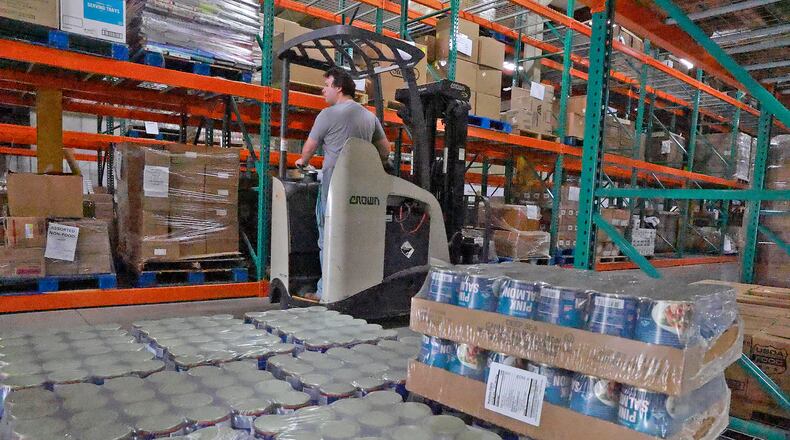“They had never before used the services, so we recognize that there are people probably in need that maybe don’t know how or where to go for help,” said Jennifer Brunner, development director, who explained they continue to work with over 60 partner agencies for them to act as ambassadors and do community outreach to let people know the food bank is there.
Credit: Bill Lackey
Credit: Bill Lackey
The food bank has made changes to its hours of distribution and what they offer because the people who are using the food bank are typically working families and adults, sometimes who have multiple jobs, that are “just having a hard time making ends meet.”
When asked about what she wants the community to know about the people they serve, she said she’d want them to know that most families don’t use the food bank on a regular basis, it’s normally one or two times a year, and that there’s a difference between food insecurity and poverty.
“Food insecurity does not equal poverty because you can be food insecure and not live in poverty. I think a lot of times people equate those as the same thing. But really, some of the neighbors that live in poverty may qualify for other government assistance that people who are food insecure don’t. They’re right on that cusp of what we call a benefits cliff, where they make just a little bit too much to qualify for some other financial support, but not enough to meet their food needs.”
In 2022, the food bank served 45,884 individuals and 22,385 households. In 2021, they served 42,842 individuals and 15,633 households.
The food bank also provided 4,976,552 meals in 2023; 4,897,790 in 2022; and 6,420,276 in 2021.
The rise in food need is due to many factors aside from the COVID pandemic, including inflation and rent costs going up.
“Where people typically have the most flexibility in their budget, if they’re going to make cuts, it’s to their food budget because they can somewhat control that,” Brunner said.
In terms of pounds of food distributed, Brunner said she’s not sure where the numbers are going to come in at yet for 2024 because the Feeding America data is a bit delayed. However, in 2023, they distributed 5,971,863 pounds of food, compared to 5,877,349 in 2022 and 7,704,332 in 2021.
“It doesn’t paint an accurate picture because during COVID and still coming off, even looking into 2022, there was still a lot of food being distributed, hundreds of pounds per family, because it was just come through a line, (food) being tossed in the back of a car,” she said, explaining that before they were giving out more bulk product that people may not have used all of.
What’s different now is that the process is more thoughtful in the food being given out. This means the poundage of food distributed in 2024 may be a little less even though they are still distributing a lot, Brunner said.
Credit: Bill Lackey
Credit: Bill Lackey
Brunner said from 2022 to 2023 food insecurity rates grew drastically as it went from 13% to 16% in Clark County and from 9% to 13% in Logan County. Data for 2024 won’t be available until next year.
The food bank was closed for three months this year during a warehouse renovation. However, they still operated their mobile distributions and still distributed food through their partner agencies.
‘Food lockers,’ other programs
Before and even during COVID, a lot of programs focused on providing food directly to people. But since it’s a small food bank, they don’t have the staff to be direct suppliers. So they are shifting towards more of their partner agencies to distribute food and finding programs that give people choice, like the Order Ahead program and food lockers, Brunner said.
The food bank does still do mobile distributions and an on-site drive-thru distribution from 9 a.m. to 6:30 p.m. on Tuesdays and Thursdays that has a set menu.
“It was needed during COVID because the pantries were closed, volunteers were not coming in, it made sense that it had to work that way,” she said. “But we’ve had time to pause and say, what have we done? What should we be doing? And what are the steps that we need to take to get there?”
As for where the food bank is going in the future, they’re trying to find better ways to streamline their services and meet people where they are through their over 60 partner agencies.
The newest program starting in January 2025 is the food lockers, another option to provide choice to neighbors and flexibility around work shifts and other things going on. Residents will be able to place customized grocery orders online, which are then prepared and made available for pick-up in refrigerated, frozen or non-temperature-controlled lockers.
“That’s why our order ahead is great and the food lockers are great because it does give people choice. When you’re able to give people choice in what they get, there’s dignity in that. They’re choosing things that make sense for their family,” Brunner said.
The food bank refers to people it serves as “neighbors” because they are more than numbers. The donations and volunteer hours they receive help real people.
“They are your neighbors. They’re the people you go to church with, they’re the people you work with, you just may not know that you helped them,” Brunner said.
The food bank has 23 employees, and 1,000 volunteers that Brunner said has saved about $300,000 in staffing last year.
To help donate, call 937-325-8715; mail a check to Second Harvest Food Bank of Clark, Champaign and Logan Counties, 20 N. Murray St., Springfield, OH 45503; or visit the website at www.theshfb.org/donate.
About the Author



